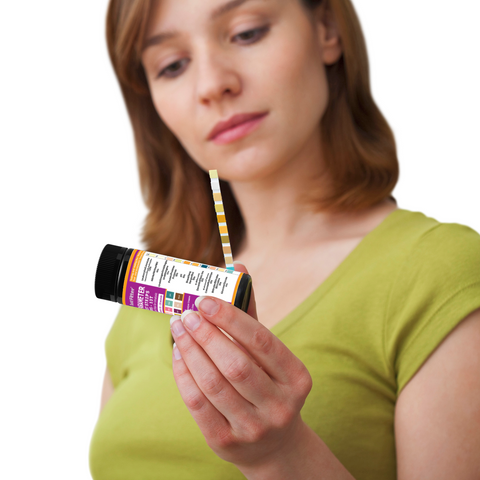
Did you know that urine is normally sterile? This means, it is completely free of bacteria and only has in it waste chemicals from all of the millions of chemical reactions that happen in your body all the time. But in some conditions chemicals that shouldn't normally be there get through the filtering systems in your kidneys and get into your urine. This is where the urine dipstick testing comes in.
WHAT YOU NEED TO KNOW ABOUT URINE DIPSTICK
A urine reagent strip or dipstick is a firm plastic strip to which pads saturated with chemicals are affixed. The chemicals in the pads indicate the presence of specific substances in the urine. The strips may also indicate the pH and specific gravity of the urine, depending on the type of strip that is used.
The urine dipstick test is the quickest way to test urine. Since it involves dipping a specially treated paper strip into a sample of your urine, your sample doesn't need to be sent to a laboratory for a urine dipstick test because this can be done easily with the results usually available within 1-2 minutes. However, if the test is abnormal, you might need to do another sample to be sent for further testing in a laboratory.
URINE DIPSTICK TEST IS AS EASY AS 1,2,3……
- Getting your sample. You need to pee or urinate straight into a sterile pot or container. Make sure you don't pee into something else and then transfer it to the container, as then it won't be sterile any more. The best sample is one which is called a midstream specimen of urine (MSU). This means that you start to pee, then pass the open container into the stream of urine, and then take it away again when you have caught enough urine. You don't stop peeing while doing this. Tightly put the lid on the pot then wash your hands and the container. It is also best performed on a full bladder first thing in the morning.
- Wait. Using a urine testing strip, make sure to immerse it into the sample urine reaching up to the last square. The strip has squares on it that changes its color in the presence of certain substances. After dipping, wait for about 60-120 seconds. You will start seeing the colors of the squares change.
- Compare your colors. This will then be compared to a chart on the side of the urine testing strip package (see sample image 10 Parameter Test Strips Color Chart). Often the more intense the color change, the more of the substance there is in the urine. Your urine can still be tested for some things if it isn't in a sterile container but the results might not be as accurate and your urine can't be tested for infection.
WHY A URINE DIPSTICK TEST IS DONE AND WHAT YOU MIGHT DISCOVER
The first thing that your doctor will do is look at your urine. Normal urine varies in color, from colorless to dark yellow. Various things can affect the way your urine looks, from how much you've been drinking to what you've eaten recently. The smell can also vary widely and is not a good gauge of illness. Thus, a urine dipstick test can be done for lots of different reasons, such as: detection of glucose, bilirubin, ketones, blood, protein, urobilinogen, nitrite, and leukocytes.
A urine dipstick test can look for the following:
pH or the level of acid in urine can be measured. Some types of kidney stones are more prone to develop in alkaline urine and others are more likely to from in acidic urine. Monitoring the urine pH may be helpful in preventing the formation of kidney stones.
Blood is not normally found in urine and may be an indication of infection. This can also be due to significant underlying disease such as cancer in the bladder or kidney and prostate gland in men. In women, it may only be contamination if you are on your period at the time of doing the sample.
Protein is normally found in the urine in tiny amounts but these tiny amounts aren't usually picked up on a urine dipstick test. Protein however, may be found in larger amounts if there is an infection or if you're pregnant and are developing pre-eclampsia. This can also be the first sign of kidney problem.
Glucose is a type of sugar that is never normally found in urine. If so, this may be a first sign of diabetes.
Ketones are chemicals made by the body when it’s breaking down fat for energy, this is what normally happens when we are starving and have used up all, or nearly all of our stored sugar. However, ketones are not usually found in urine, and are present when your diabetes is out of control and the levels of sugar in the blood are very high.
Bilirubin and Urobilinogen are chemicals produced by the liver and are not normally found in the urine. But if bilirubin is found in the urine it usually indicates a liver problem. While small amounts of urobilinogen is normal, large amounts may also suggest a liver problem or problem with the red blood cells being destroyed too quickly.
Leukocyte esterase and Nitrite are both indicators for the presence of infection. Leukocyte esterase test looks for a reaction that only happens if there are lots of white cells in the urine because white cells get into the urine when there is an infection. Nitrite is not normally found in the urine but will appear there if there are lots of germs or bacteria in the urine.
Specific Gravity or the comparison in density of urine to the density of water. This quick test can help determine how well your kidneys are diluting your urine. Urine that's too concentrated could mean that your kidneys aren't functioning properly or that you aren't drinking enough water.

10 Parameter Test Strips Color Chart
UNDERSTANDING HEALTH CHECKS
Regular health checks can identify any early signs of health issues. Hence, the importance of self-monitoring or keeping an eye on one’s health which may help the controllability of disease and other health problems. With the ease and availability of urine dipsticks, it is easier to help determine any probable health problems related to the two most essential and hardworking organs in the body: the liver and kidneys.
Liver Health Check and Kidney Health Check
The Liver and Kidneys carry out numerous functions such as excretion of waste, metabolism of many substances, hormonal regulation, and proper digestion, as well as proper coagulation.
Over time, conditions that damage the liver can lead to scarring (cirrhosis), which can lead to liver problems and can be life-threatening. But early treatment may give the liver time to heal.
Likewise, some kidney problems can be early signs of chronic kidney disease (CKD), the type of kidney damage that can get worse over time and lead to kidney problems or even kidney failure. Finding and treating these problems early can help prevent CKD from becoming kidney failure. Other kidney problems can lead to CKD if they are not treated. Hence, doing a simple regular examination of your urine may be key to earlier detection of liver and kidney problems.
CONCLUSION
Your urine holds the clues. The color and density, even the smell of your urine, can reveal factors regarding your state of health. Such as the blood and protein in your pee could be signs of kidney problems or the bilirubin and urobilinogen levels help determine health of your liver. A simple urine dipstick which is easy to use and readily available for home testing, can help save a life. Though prevention is always better than cure, early detection still holds importance in health restoration. However, despite the ease availability of these urine strips, a doctor’s expertise in your overall health is still vital. Hence, home use urine test strips are NOT intended for self-diagnosis purposes, and should only be used in consultation with your doctor. Overall, knowing your body and contacting your health care provider when you notice something isn’t right can help you prevent bigger problems in the future.
With all that you’ve learned, this may no longer sound comical to you, so......
HAVE YOU CHECKED YOUR URINE TODAY?
References
- http://www.linear.es/ficheros/archivos/7101505_Urine_Strip_10_p_150_Test.pdf
- https://patient.info/treatment-medication/urine-dipstick-test
- https://www.diagnoxhealth.com/10-parameter-urinalysis-test-at-home/
- https://geekymedics.com/urinalysis-osce-guide/
- https://www.mayoclinic.org/diseases-conditions/liver-problems/symptoms-causes/syc-20374502
- https://www.mayoclinic.org/diseases-conditions/chronic-kidney-disease/symptoms-causes/syc-20354521





